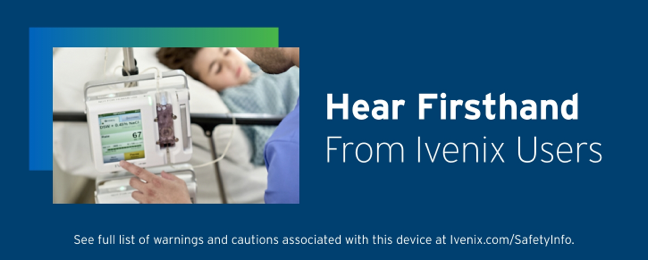
The Problem With Intermittent Infusions and Residual Volume
The two methods of delivering intermittent infusions are as a primary or secondary infusion. When delivering an intermittent infusion as a primary infusion, the container with the medication is attached to a primary administration set. Secondary infusions are attached to the primary line through a Y-site and typically involve smaller volumes. While smart pumps automate the infusion process, ensuring complete delivery of intermittent infusions may be more complex than it appears.1,2
Residual volume (RV)—the medication left in the tubing after the infusion completes—can keep the full dose from reaching the patient. This issue is particularly problematic with small-volume infusions, where even a small amount of residual volume can represent a significant percentage of the total dose.1,2
A 2020 ISMP report highlighted the scope of this issue. One hospital system-wide evaluation revealed that only 35.7% of small-volume intermittent infusions were administered correctly through secondary administration sets, leaving the remaining 64.3% potentially underdosed due to improper administration methods and residual volume concerns.1
The Reality of Fluid Remaining in the Bag
When using a primary administration set for small-volume intermittent infusions instead of a secondary infusion set, medication loss can occur. While the intent is to deliver the full dose of medication or total volume in the bag, bottle, or syringe, even some smart pumps fall short. This is often due to several factors1,3:
- Volume to Be Infused (VTBI): If the infusion is programmed to deliver only the prescribed dose or the volume on the label, the infusion may stop prematurely. There is often overfill in the bag due to compounding and manufacturer overfill. This potentially leaves a clinically significant volume of medication undelivered.
- Residual Volume in the Tubing: Primary administration sets hold a significant amount of residual volume (e.g., 25 mL) in the tubing after the infusion, which prevents the full dose of medication from reaching the patient.
- Inadequate Flushing: Without adequate flushing of the tubing, the residual volume of the medication remaining in the tubing may not be administered to the patient, leading to a significant underdose.
ISMP Strategies to Help Mitigate Residual Volume3:
Administer as a Secondary Infusion: Most small-volume intermittent infusions should be administered through secondary infusions, not primary infusions. Some smart pumps allow the use of short primary administration sets, which can be used to administer small volume intermittent infusions. Using a short primary administration set avoids concerns with unopened roller clamps, head-height differentials, and limitations in concurrent flow rates, while significantly limiting the potential for significant residual volume remaining in the tubing.
Use Microbore Tubing: Consider using microbore (small bore) administration sets for the primary infusion or carrier fluid to minimize the residual volume left in the tubing. Microbore tubing has a lower priming volume compared to macrobore (regular bore) tubing, thus reducing the residual volume left in the tubing. For the small-volume intermittent infusion, use a secondary administration set with the smallest priming volume that can be used with the pump.
Provide an Accurate VTBI: The ISMP has long recommended that the pharmacy label on the bag explicitly states how to deliver the entire dose, including all overfill and additive amounts. The pharmacy should include the actual total VTBI on the label, combining an estimate of the manufacturer’s overfill, the exact volume of all additives, and the stated volume in the bag (e.g., 50 mL).
Use Pump Alarms to Detect Unopened Clamps: Historically, closed roller clamps on small-volume intermittent infusions have happened more frequently than reported, leading to delays in administration and/or omissions. There is no easy remedy for this human failure mode; however, some infusion pumps can sense an upstream occlusion if the roller clamp leading to the intermittent infusion is closed, thereby alerting the clinician to check and release any clamps.
Flush the Line: Most smart infusion pumps can automatically switch to the primary infusion or carrier fluid when a small-volume intermittent infusion is complete. However, any medication remaining in the tubing is often delivered at the slower primary infusion or carrier fluid rate, which can take hours. Newer pump models offer an “automatic secondary flush” feature that clears the tubing at the intermittent infusion rate using an adequate volume of primary infusion fluid, before returning to the primary infusion or carrier rate. Alternatively, clinicians can manually flush the tubing or use a line-flushing feature to ensure the full dose is delivered.
Ivenix’s Approach to Infusion Efficiency

With Ivenix, the infusion is complete only when both the bag and secondary tubing are empty.
With the Ivenix Infusion System, we’ve taken these challenges into account and developed a smart infusion system that infuses the programmed volume plus any overfill in the bag. The infusion is complete only when both the bag and secondary tubing are empty.4
How It Works
- When setting up a secondary infusion, the pump will provide an option to select “until empty.”4
- The administration cassette will4:
- Detect a closed roller clamp on the secondary set and
- Infuse the secondary line to empty and resume the primary if the clinician chooses for the infusion to resume back to the primary.

With the “infuse to empty” feature, nurses are not burdened with:
- Overprogramming the VTBI
- Returning to the pump to:
- Ensure the entire drug was delivered
- Reprogram the VTBI to account for overfill
- Restart the primary infusion
Why It Matters
Ensuring that smart pumps can infuse until the bag is nearly empty is not just a matter of efficiency. By maximizing the delivery of medications and fluids, healthcare providers can help to ensure patients receive their full prescribed medication dosages and reduce waste.
While not all smart pumps can infuse until the secondary bag is empty, we have made significant strides in addressing this issue and others. The technology used in the Ivenix LVP also detects closed secondary roller clamps. Our commitment to innovation and helping to improve patient safety drives us to continually improve our technology, helping to ensure that we meet the needs of healthcare providers and patients alike.
At Fresenius Kabi, we believe that every drop counts. The Ivenix Infusion System is designed to deliver medications and fluids with precision and efficiency, helping to ensure that nothing goes to waste.4
Please see the full list of warnings and cautions associated with this device
- Institute for Safe Medication Practices. Hidden medication loss when using a primary administration set for small-volume intermittent infusions (https://home.ecri.org/blogs/ismp-alerts-and-articles-library/hidden-medication-loss-when-using-a-primary-administration-set-for-small-volume-intermittent-infusions?_pos=1&_sid=473156388&_ss=r). ISMP Medication Safety Alert! 2020;25(24):1-4.
- Harding M, Stefka S, Bailey M, Morgan D, Anderson A. Best practice for delivering small-volume intermittent intravenous infusions. J Infus Nurs. 2020;43(1):47-52.
- Institute for Safe Medication Practices. Additional strategies to improve complete delivery of small-volume intermittent infusions. April 8, 2021. https://home.ecri.org/blogs/ismp-alerts-and-articles-library/additional-strategies-to-improve-complete-delivery-of-small-volume-intermittent-infusions.
- Ivenix Infusion System Large Volume Pump (LVP) Instructions for Use. Bad Homburg, Germany: Fresenius Kabi; 2024.


